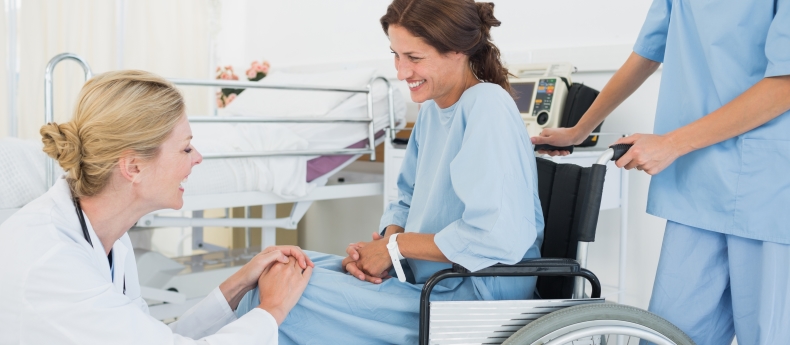
Fall Prevention
Are you at risk of falls?
Falls are the main cause of injuries in people 65 years and older. Nevertheless, falls can happen at any age, anytime, and anywhere. Serious injuries can occur, such as hip, spine, or wrist fractures or head injuries. Tell your healthcare team if you have bleeding problems or a blood disorder. You may be at greater risk of serious injury if a fall occurs.
Why am I at risk of falling in the hospital?
- Recent illness
- Fall history
- Recent surgery
- Age: people over 65 are at greater risk of falls
- Slippery or poor-fitting footwear
- Urgent need to go to the bathroom
- Confusion
- Taking multiple medicines, especially if they cause drowsiness or a drop in blood pressure
- Unfamiliar environment
Your health and safety are important to us. We are committed to reducing the risk of falls and fall-related injuries, while minimizing the use of restraints in our healthcare facilities.
Here are some ways we can work together to reduce your risk of falling while in the hospital.
Before you get out of bed…
- Do not feel like you are a burden! Ask the nursing staff for assistance, especially at night, by using your call bell. Please be patient and wait for help to arrive.
- If it is dark, have the lights turned on over your bed and/or in your room.
- Sit on the bed for a minute before you stand up. Standing up quickly or after being in bed for a long time can make you dizzy.
- Wear well-fitting footwear.
- If you have a walking aid, make sure to use it at all times. Ask for help if your walking aid is not within reach.
- Get your balance before you start to walk.
Think about your environment
Bathroom: Falls commonly occur when getting up to go to the bathroom. Ask for assistance if needed. Use the handrails by the toilet and sink.
Room furniture: Do not use furniture to support yourself. It may be on wheels.
Floor: Report any spills or obstacles on the floor to staff.
Wheelchair: Make sure the brakes are on before sitting down or standing up.
Belongings: Keep personal items within easy reach.
Vision & hearing: Wear your glasses and/or hearing aids. Make sure they are working properly.
Footwear: Wear well-fitting footwear – flat, enclosed heels, rubber soles, and lace-up shoes are best. Do not walk around in your bare feet or socks.
Think about hospital bed safety
Bed height: Unless your therapist advises otherwise, your bed should be at knee height when you are getting out. Staff can adjust the bed for you.
Call bell: Make sure to have your call bell within reach.
Bed rails: NEVER climb over bed rails. If bed rails are up, use your call bell to get help. You risk a more serious injury by climbing over bed rails as the fall is from a greater height. Leaving the bed rails down promotes your mobility and independence and reduces feelings of isolation or restriction.
Here are some ways we can work together to reduce your risk of falling while in our facilities:
- Waiting area: Keep it clean and tidy, with no toys, loose paper, boxes, or wires on the floor.
- Furniture: Have corner protectors on tables and other objects with sharp edges.
- Caution signs: Signs will be present if there is a wet floor.
- Safety strips and hand railings: Safety precautions are present on all slopes and stairs.
- Washrooms: Washrooms are equipped with call bells and railings.
- Wheelchairs and crutches: Assistive devices are available in the clinic. Ask a nurse if you are in need.
- Narrow examination tables: Be alert to prevent falls if you are being examined on a narrow procedure table.
- Children’s safety: Please do not leave children unattended in examination rooms or on examination tables.
Ask the staff if you have any questions or concerns.
Together we will reduce the risk of falls and fall-related injuries.





